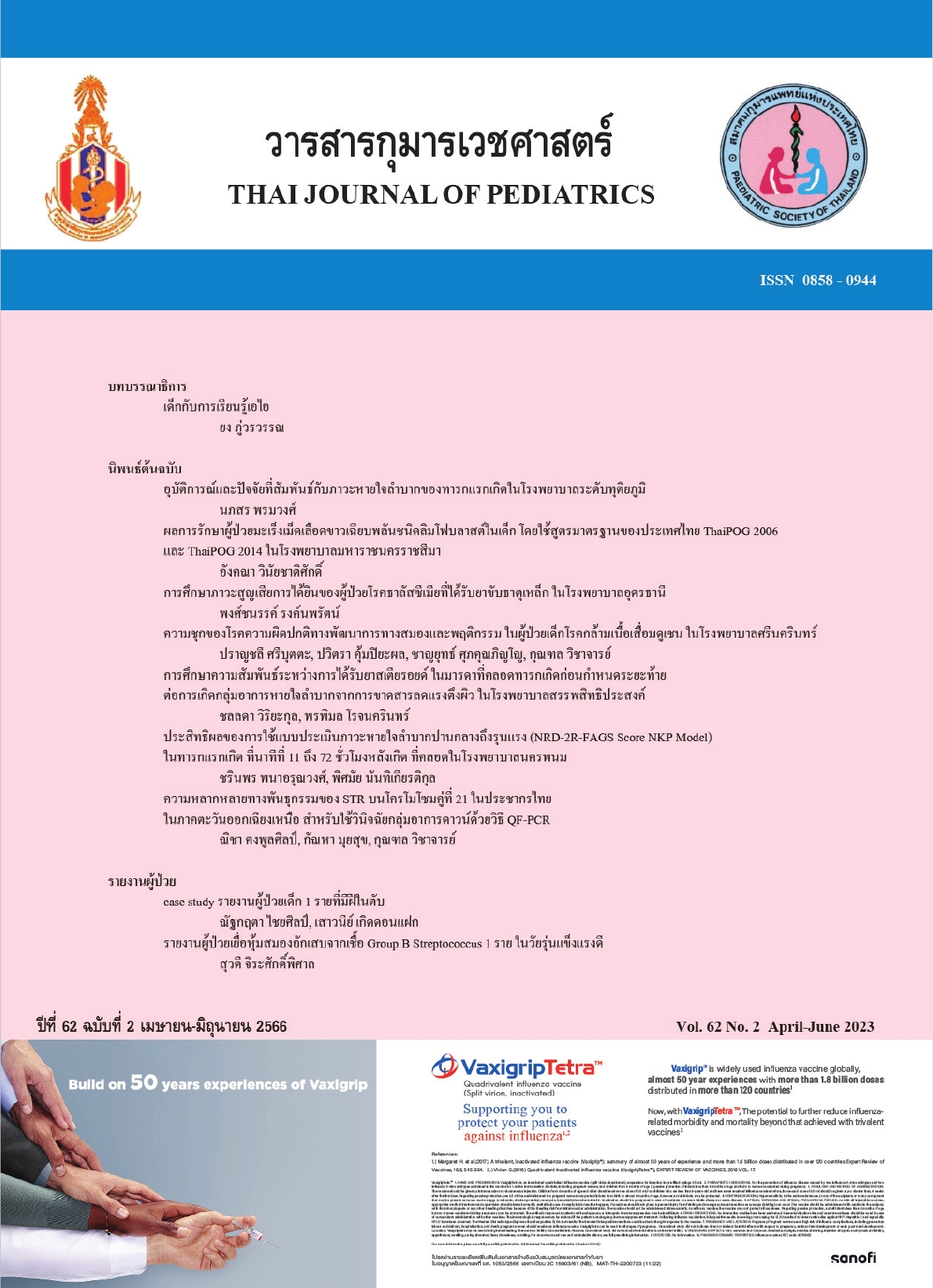ความหลากหลายทางพันธุกรรมของ STR บนโครโมโซมคู่ที่ 21 ในประชากรไทยในภาคตะวันออกเฉียงเหนือ สำหรับใช้วินิจฉัยกลุ่มอาการดาวน์ด้วยวิธี QF-PCR
คำสำคัญ:
Short tandem repeats (STR), QF-PCR (Quantitative fluorescent PCR), Down syndromeบทคัดย่อ
ความเป็นมา: Short tandem repeats (STR) เป็น microsatellites markers ที่มีความหลากหลายนิยมใช้ในการวินิจฉัยโรค Down syndrome (DS) ด้วยวิธี Quantitative fluorescent PCR (QF-PCR)
วัตถุประสงค์: คัดเลือก STR markers ที่เหมาะสมในการวินิจฉัย DS ด้วยวิธี QF-PCR สำหรับคนไทยในภาคตะวันออกเฉียงเหนือ
วิธีการศึกษา: วิเคราะห์ตัวอย่างเลือดผู้ป่วย DS 26 ตัวอย่างด้วยวิธี QF-PCR เพื่อหา STR loci ที่ให้ผล informative มากที่สุดและวิเคราะห์ตัวอย่างเลือดประชากรไทยภาคตะวันออกเฉียงเหนือปกติ 191 ตัวอย่าง ด้วยวิธี QF-PCR เพื่อหา STR loci ที่มีความหลากหลายมากที่สุด
ผลการศึกษาและอภิปราย: จากการวิเคราะห์ทั้งหมด 6 STR loci พบว่าตำแหน่งที่ให้ผล informative สูงสุดในตัวอย่าง DS 3 อันดับแรก ได้แก่ D21S11 (92.3%), D21S1411 (84.6%), และ D21S1442 (84.6%) ตามลำดับ STRloci ที่มีค่าสัมประสิทธิ์ของการแปรผันสูงสุด ได้แก่ D21S1444, D21S1437, และ D21S1411 เมื่อใช้ STR loci 3 ตำแหน่งที่ให้ผล informative มากที่สุดมาวินิจฉัย DS เปรียบเทียบกับ STR loci ที่มีค่าสัมประสิทธิ์ของการแปรผันสูงสุด พบว่าสามารถวินิจฉัย DS ได้เท่ากันโดยมีความไว 96.1% แต่พบว่า D21S1437 และ D21S1444 มี allele ที่มีความถี่ในประชากรสูงถึง 33.3 และ 28.3% ตามลำดับดังนั้น STR loci ที่เหมาะสม 3 ลำดับแรก คือ D21S11, D21S1411, และ D21S1442
สรุป: D21S11, D21S1411, และ D21S1442 เป็น STR loci ที่เหมาะสมที่สุดในการวินิจฉัย DS ในกลุ่มประชากรไทยภาคตะวันออกเฉียงเหนือ
Downloads
เอกสารอ้างอิง
Toth G, Gaspari Z, Jurka J. Microsatellites in different eukaryotic genomes: survey and analysis. Genome Res. 2000,10:967-81.
Fan H, Chu JY. A brief review of short tandem repeat mutation. Genomics Proteomics Bioinformatics. 2007;5:7-14.
Ellegren H. Heterogeneous mutation processes in human microsatellite DNA sequences. Nat. Genet. 2000;24:400–2.
Lander ES, Linton LM, Birren B, et al. Initial sequencing and analysis of the human genome. Nature. 2001;409(6822):860-921.
Huang Q.Y. Mutation patterns at dinucleotide microsatellite loci in humans. Am J Hum Genet. 2002;70:625-34.
Kayser M. Characteristics and frequency of germline mutations at microsatellite loci from the human Y chromosome, as revealed
by direct observation in father/son pairs. Am J Hum Genet. 2000;66(5):1580-8.
Chakraborty R, Kimmel M, Stivers DN, Davison LJ, Deka R. Relative mutation rates at di-, tri-, and tetranucleotide microsatellite loci.
Proc Natl Acad Sci USA. 1997;94(3):1041-6.
Bowcock AM, Ruiz-Linares A, Tomfohrde J, Minch E, Kidd JR, Cavalli-Sforza LL. High resolution of human evolutionary trees with polymorphic microsatellites. Nature. 1994;368(6470):455-7.
Hammond HA, Jin L, Zhong Y, Caskey CT, Chakraborty R. Evaluation of 13 short tandem repeat loci for use in personal identification applications. Am J Hum Genet. 1994;55:175-89.
Dib C, Faure S, Fizames C, et al. A comprehensive genetic map of the human genome based on 5,264 microsatellites. Nature. 1996;380:152-4.
Muthuswamy S, Agarwal S. Segmental Duplication QF-PCR: A Simple and Alternative Method of Rapid Aneuploidy Testing for Developing Country Like India. J Clin Lab Anal. 2017;31:e22038.
Lee MH, Ryu HM, Kim DJ, et al. Rapid prenatal diagnosis of Down Syndrome using quantitative fluorescent PCR in uncultured
amniocytes. J Korean Med Sci. 2004;19:341-4.
Mackic-Durovic M, Projic P, Ibrulj S, Cakar J, Marjanovic D. A comparative analysis of the effectiveness of cytogenetic and
molecular genetic methods in the detection of Down syndrome. Bosn J Basic Med Sci. 2014;14:94-8.
Svecova I, BurjanivovA T, Krsiakova J, et al. Rapid detection of the most common chromosomal aneuploidies in the secondtrimester
amniotic fluid using QF-PCR. Ceska Gynekol. 2013;78:373-8.
Guan L, Ren C, Li H, Gao L, Jia N, Guan H. Practicality of rapid prenatal screening for Down syndrome with PCR-short tandem
repeat method. Zhonghua Yi Xue Yi Chuan Xue Za Zhi. 2013;30:277-82.
Shi YF, Li XZ, Li Y, Zhang XL, Zhang Y, Yue TF. Diagnosis of Down’s syndrome using short tandem repeat loci D21S11, D21S1440
and Penta D. Zhonghua Yi Xue Yi Chuan Xue Za Zhi. 2012;29:443-6.
Kriventsova NV, Shokarev RA, Avrutskaia VV, et al. Use of quantitative fluorescence polymerase chain reaction in the invasive
prenatal diagnosis of Down’s syndrome. Klin Lab Diagn. 2010;:27-30.
Jain S, Agarwal S, Panigrahi I, Tamhankar P, Phadke S. Diagnosis of Down syndrome and detection of origin of nondisjunction by
short tandem repeat analysis. Genet Test Mol Biomarkers. 2010;14:489-91.
Liou JD, Chu DC, Cheng PJ, et al. Human chromosome 21-specific DNA markers are useful in prenatal detection of Down syndrome. Ann Clin Lab Sci. 2004;34:319-23.
Yang LL, Ou YH, Xu XM. Rapid molecular diagnosis of trisomy 21 using the PCR-STRSSCP technique. Zhonghua Yi Xue Yi Chuan
Xue Za Zhi. 2004;21:466-9.
Tóth T, Findlay I, Papp C, et al. Pre-natal detection of trisomy 21 and 18 from amniotic fluid by quantitative fluorescent polymerase
chain reaction. J Med Genet. 1998;35:126-9.
Zhu YN, Lu SM, Wang M, Shen FX, Chen Y, Hu JJ. Genetic analysis of STR markers on chromosome 21 in a Han population from southeast China. Genet Mol Res. 2015;14:1718-25.
Mann K, Fox SP, Abbs SJ, et al. Development and implementation of a new rapid aneuploidy diagnostic service within the
UK National Health Service and implications for the future of prenatal diagnosis. Lancet. 2001;358(9287):1057-61.
Wongkularb A, Rerkamnuaychoke B, Weerakiet S, Navephap S, Campiranon A. Genetic Diagnosis of Sex and Trisomies 13, 18, 21 in Human Single Cell Embryo by Multiplex Fluorescent Polymerase Chain Reaction. Kasetsart J. (Nat. Sci.). 2005;39:440-5.
Khorchai A, Rerkamnuaychoke B, Sangkitporn S, et al. Detection of Down Syndrome by Multiplex Fluorescent Polymerase Chain Reaction. Journal of Health Science. 2014;23(5),943-53.
ดาวน์โหลด
เผยแพร่แล้ว
รูปแบบการอ้างอิง
ฉบับ
ประเภทบทความ
สัญญาอนุญาต

อนุญาตภายใต้เงื่อนไข Creative Commons Attribution-NonCommercial-NoDerivatives 4.0 International License.



